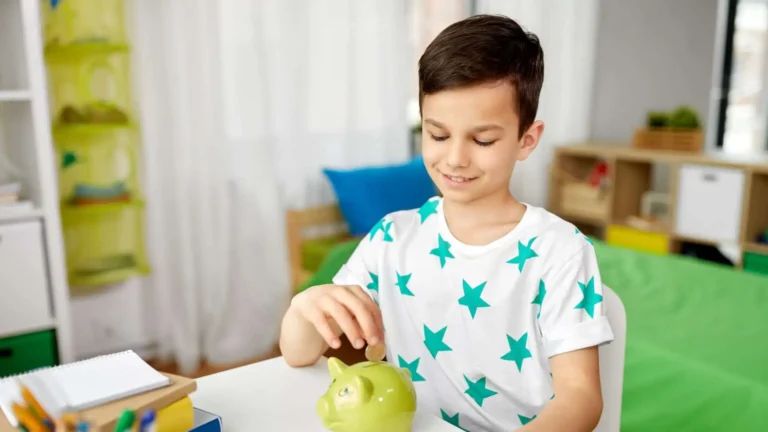Table of Contents
Introduction
Children’s first real exposure to money is through pocket money, which plays an important role in teaching them about financial responsibility. The role of pocket money goes beyond just a few cents or notes from parents—it helps clarify trade-offs, value, and decision-making.
Direct use of pocket money is one of the simplest and most effective ways to educate children in terms of financial literacy. It informs children that money does not appear out of thin air; it must be earned, managed, and appreciated.
Consider it their initial mini-economy, wherein they make decisions, learn from their mistakes, and acquire emotional and financial intelligence.
Just as Beem’s Everdraft™ feature helps adults effectively handle sporadic financial shortfalls by striking a balance between flexibility and control, pocket money teaches children the same fundamental concepts in a secure and encouraging setting.
Why Pocket Money Matters in a Child’s Financial Education
Kids can purchase more than just snacks and toys with their pocket money. Other financial ideas that are taught include self-discipline, budgeting, and delayed gratification.
Regularly giving children a set amount teaches them patterns: if you spend too much, you’ll be broke for the week; if you save, you can buy something valuable.
This is the first test of mini, low-stakes impacts I have ever dealt with. When one runs out of money, they learn to control themselves and plan more wisely.
Making sound financial decisions as an adult often results from structured money management during childhood. They know when to wait, save, and spend, in addition to generating income.
Similar to adult Everdraft™, pocket money gives you the freedom to do as you like, but it also comes with the responsibility of exercising caution and making quick decisions.
Also Read: How to Teach Kids About Financial Mistakes Without Real Risks
Step 1 — Decide When and How to Introduce Pocket Money
Most parents agree that ages 5 to 8 are the best starting point, even though there is no specific age. You should be old enough to start thinking practically and to learn skills and prepare for the future. At this stage, children learn simple numbers, options, and cause-and-effect relationships.
Begin modestly with work-based payments that are made on a monthly or biweekly basis.
For example:
- Weekly pocket money to set the table for dinner.
- Extra effort is rewarded.
Children learn from this early foundation that money is earned via contributions rather than charity.
Their perspectives on work, rewards, and independence will be shaped by the belief that hard work is rewarded.
It adheres to Everdraft™, which prioritizes responsible, well-rounded, and organized adults over those who avoid problems.
Step 2 — Define Clear Rules and Purpose
It shouldn’t feel like pocket money to receive free money. Children require boundaries on accountability.
Determine the regulations of the division of mutual funds:
- Saving: Saving up to buy something significant or for long-term goals.
- Spending: Small desires.
- Sharing: Endorsing worthwhile causes.
Promote preparation above rash purchases. Steer clear of the temptation to spend their money again right away. Await the subsequent cycle.
These abilities help individuals balance flexibility and control in financial products like Everdraft™ by teaching them patience, foresight, and accountability.
Step 3 — Encourage Saving Before Spending
For children, “pay yourself first” is the most important instruction.
The conventional three-envelope or three-jar method:
- Save
- Spend
- Distribute
If your child receives $10, recommend:
- Conserve $4.
- $4 to spend
- $2 per share
Children can see their development using colourful trackers or glass jars.
They appreciate perseverance while saving for a toy, book, or piece of equipment. The sense of achievement is motivating.
Adults can effectively balance short-term cash needs with financial security using Everdraft™ and other tools, which have a positive emotional impact.
Step 4 — Link Pocket Money to Real-World Lessons
Conversely, there are many ways to make money each day and use it to create teaching opportunities.
When you shop for groceries:
- Don’t let your kids go shopping.
- Discuss the “needs vs. wants.”
- Talk about the reasons some things are worth waiting for.
Thus: “We can save for your weekend trip if we forego takeout tonight.”
These short conversations help children understand priorities, trade-offs, and that saying “not now” often means “yes later.”
Adults prioritize necessities over wants when using short-term flexibility tools like Everdraft™.
Step 5 — Introduce Earning Opportunities Beyond Allowance
Extra money encourages initiative, even though established pocket money is fantastic.
Provide methods for making money while doing good:
- Arranging a section or shelf.
- Aiding a sibling in their studies.
- Water the plants regularly.
This reinforces the relationship between hard work and pay, confirming that money is not obtained by birthright.
Include part-time employment, internet activities, or skill-based income of older children.
It demonstrates how individuals may achieve financial success by taking initiative, learning, and staying ahead of the curve with tools like Everdraft™.
Step 6 — Help Kids Learn from Spending Mistakes
Even the best finance instructors make mistakes.
Don’t give your child more pocket money if they spend it all at once. Rather, discuss:
- What prompted your sudden desire for that?
- Was it worthwhile?
- What would you have done differently the next time?
Help them think and not be depressed. Perhaps maintain a spending log to identify patterns.
Adults recognize the need for structure and oversight. Adults are expensive. Thankfully, before the stakes are raised, children can learn these skills in a secure setting.
Like Everdraft™, this introspective method cultivates financial awareness through deliberate use, review, and improvement.
Step 7 — Introduce Budgeting Concepts Gradually
Once children are at ease with saving and spending, introduce them to basic budgeting.
Involve them in little family choices, such as:
- Planning a shopping expedition.
- Establishing travel restrictions.
- Figuring out the expenses of the gathering.
Ensure that they realize the impact of their decisions everywhere.
Therefore, “Then we can adjust our family movie to next week, provided we can save 30 of our dollars by house cooking this week.
These discussions teach kids that money is a component of a system, a dynamic flow where decisions impact one another.
Everdraft™ users manage time, priorities, and resources to maintain stability.
Step 8 — Make Saving Fun and Rewarding
Consistency is increased by enjoyment. Honor savings milestones as though they were accomplishments.
Ideas:
- Use stickers to create a Savings Milestone Board.
- Provide small matching bonuses based on interest.
- Let them discuss their progress during family conversations.
There are advantages to sound financial practices. Instead of tension, saving turns into pride.
Healthy adult financial habits are the result of using Everdraft™ sensibly rather than rashly.
Step 9 — Encourage Discussions About Sharing and Giving
Compassion and purpose, not merely accumulation, are necessary for proper financial knowledge.
Encourage your child to make a pocket money donation to animal shelters, school drives, or local organizations.
Prove to them that money may be used for purposes other than happiness. It cultivates empathy and thankfulness.
It’s similar to Beem’s Everdraft™ goal of assisting those in need in a responsible and caring manner.
When handled with compassion, money can be a tool for survival and social interaction.
Step 10 — Gradually Introduce Digital Money Awareness
As your youngster grows older, teach them about digital currency.
Talk about online payments, security, and digital wallets.
Prove to them that even if digital currency is “invisible,” it still requires self-control.
Begin with easy exercises:
- Monitoring a collaborative online buy.
- Contrasting debit and credit.
- Talking about the adult Everdraft™ repayment strategy.
They are better prepared for adulthood, when digital awareness is just as important as emotional awareness, thanks to this early experience.
It links financial maturity and early schooling.
Also Read: What Every Parent Should Know About Teaching Kids Smart Shopping
How Beem’s Everdraft™ Reinforces Lessons from Pocket Money
Like pocket money teaches children, Beem’s Everdraft™ feature teaches adults financial flexibility and responsibility.
It offers short-term, debt-free, interest-free cash when life throws a curveball.
Use Everdraft™ to provide your children with a relatable example:
“Observe how we pre-allocate costs? We use Everdraft™ selectively and make timely repayments in an emergency, just as you choose when to save or spend your pocket money.
This illustration demonstrates to children that borrowing money isn’t always “bad”—it depends on due diligence, timing, and awareness.
Values are passed down through generations when early pocket money teachings are combined with adult financial tools and emotional intelligence.
Conclusion
Even if it’s modest, pocket money makes a big difference. It teaches children compassion, perseverance, and hard work, changing their thoughts, feelings, and behaviours around money.
Adequate supervision enables children to manage their finances effectively and make informed decisions. Applying those lessons to real-world situations, such as Beem’s Everdraft™, demonstrates to them how sound financial practices throughout youth contribute to adult poise and confidence.
Instead of controlling, pocket money empowers.
It teaches children knowledge, choice, and ownership, making them wiser than just terrific savers.
FAQs on the Role of Pocket Money in Teaching Financial Responsibility
At what age should I start giving pocket money?
Children are at their best between the ages of 5 and 8, when they can count, make simple judgments, and comprehend how money connects work to reward.
Should pocket money be tied to chores?
Link it to your involvement or job. Children learn from this that money is obtained via hard work rather than as a right.
How much pocket money should I give?
Start small, just enough for tiny choices. Make adjustments for age, responsibility, and family finances. The objective is to teach value rather than quantity.
What if my child spends all their pocket money too fast?
Apply the consequences to them. Introspection produces stronger habits than restraint. Discuss the things they learned and how they might do better in the future.
How does Beem’s Everdraft™ connect to pocket money lessons?
Everdraft™ is the pinnacle of responsible practicality. It highlights that borrowing and flexibility can be beneficial when used correctly, much like pocket money helps children to save, spend, and plan with purpose.















































